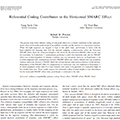Abstract
The present study tested whether coding of tone pitch relative to a referent contributes to the correspondence effect between the pitch height of an auditory stimulus and the location of a lateralized response. When left–right responses are mapped to high or low pitch tones, performance is better with the high–right/low–left mapping than with the opposite mapping, a phenomenon called the horizontal SMARC effect. However, when pitch height is task irrelevant, the horizontal SMARC effect occurs only for musicians. In Experiment 1, nonmusicians performed a pitch discrimination task, and the SMARC effect was evident regardless of whether a referent tone was presented. However, in Experiment 2, for a timbre-judgment task, nonmusicians showed a SMARC effect only when a referent tone was presented, whereas musicians showed a SMARC effect that did not interact with presence/absence of the referent. Dependence of the SMARC effect for nonmusicians on a reference tone was replicated in Experiment 3, in which judgments of the color of a visual stimulus were made in the presence of a concurrent high- or low-pitched pure tone. These results suggest that referential coding of pitch height is a key determinant for the horizontal SMARC effect when pitch height is irrelevant to the task.
